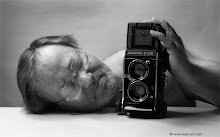Lomography with a screw-in Leica or Bessa-R???
 |
| Bessa R with Chaika-Lense. |
On the search for an affordable 28mm lens for the Bessa-R (39mm - LTM), I found the lenses for the Russian Smena offered in heaps. Now it is a half-frame camera. That's why I was curious to see how large the actual image circle of this lens is in "full format".
The result is really “lomo-like”:
the image is sharp in the center, with distortions towards the edges and strong vignetting.
I have to say that I "rape" my films (Fomapan 400) with 800 ASA anyway, with a stand development of over 3 hours in 100 parts water + 1 part Rodinal at 20 °C.
In fact, there are better drawings in the shadows, which are often very thin on the Fomapan 400 in Rodinal. However, the grain becomes obvious in the process.
 | |
| Negatives made with 28mm Lens. |
In order to add the (colored) crown to the whole thing, I tried various colorings. Last night I got stuck with a filter in GraficConverter that really goes "deep": "DeepAI.org" offers it for free trials, if you use it regularly you have to register, but it remains free.
 |
| Tree, taken with the 28 mm Chaika-Lens. |
 |
| The same Motive, colored by "DeepAI.org" |
In the original, the screw thread is "approximately" Leica. In order to actually screw this lens onto a Leica/Bessa-R, it has to be modified and the infinity setting also has to be adjusted.
Sounds complicated, but these modified lenses are (still) often available on eBay (from Ukraine / may the force be with them!).
Own experiances? Write me.
-ekk-
























